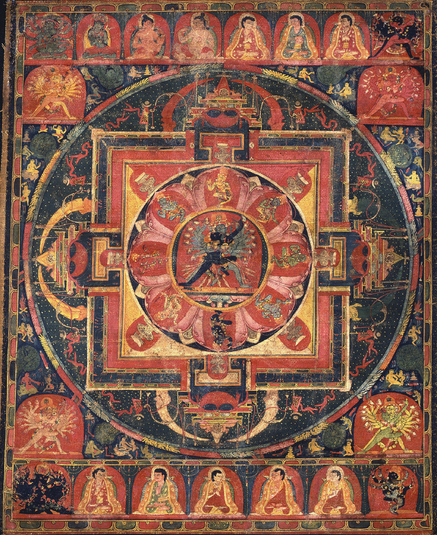
Item: Mandala of Hevajra (Buddhist Deity) - (Hevajra Tantra)
| Origin Location | Tibet |
|---|---|
| Date Range | 1300 - 1399 |
| Lineages | Buddhist |
| Material | Ground Mineral Pigment on Cotton |
| Collection | Private |
Shri Hevajra Nine Deity Manadala (Tibetan: pal gye pa dor je lha gu'i khyil kor): according to the lineage Marpa Chokyi Lodro and Ngogton Choku Dorje.
Sanskrit: Hevajra Tibetan: Gye pa dor je
Tibetan: Gye pa dor je
Within the center of the two dimensional circular diagram (mandala) representing the top view of a three dimensional celestial palace and surroundings is the deity Shri Hevajra, dark blue in colour, with eight faces and sixteen hands holding skullcups, standing with four legs in a dancing posture. The first pair of hands embrace the consort Vajra Nairatmya (Selfless One), blue, with one face and two hands holding a curved knife and skullcup, standing on the left leg with the right embracing Hevajra. They are both adorned with bone ornaments and stand atop four corpses within the flames of pristine awareness.
Surrounding the two central figures are eight goddesses of various colours, each with one face and two hands, standing in a dancing posture on the left leg above a corpse seat. Beginning at the top and placed in a clockwise direction is yellow Vetali, multi-coloured Dombini, green Ghasmari, blue Pukkasi, black Gauri, white Shavari, red Cauri, and purple Candali. They are adorned with various ornaments and each hold their own distinct hand objects.
The floor of the celestial palace is divided into four colours ornately patterned with floral designs: red, blue, white and yellow. The outer red and white lines forming a square enclosure represent the stylized decorative facade on the four sides of the palace roof; adorned with banners. The elaborate lintels above each of the four doors are constructed of tiered steps topped with a Dharma wheel, two reclining deer, and stupa-like spires above. Surrounding the palace is a circle vajras and a circle of wisdom fire in five colours completely enveloping the entire Hevajra Mandala. Outside of that are the eight cemeteries.
At the upper right corner is Amitabha Hevajra, red in colour, lower right Amoghasiddhi Hevajra, green, lower left Vairochana Hevajra, white, upper left Ratnasambhava Hevajra, yellow.
Along the top are the lineage gurus for this particular mandala of Shri Hevajra. Shri Hevajra acccording to the Marpa Kagyu system is a meditational deity of the Anuttarayoga classification of Tantra.
Numbered List:
1. Vajradhara
2. Tilopa
3. Naropa
4. Marpa Chokyi Lodro
5. Ngogton Choku Dorje
6. Tibetan Lama
7. Tibetan Lama
8. Tibetan Lama
9. Tibetan Lama
10. Tibetan Lama
11. Tibetan Lama
A. Akshobhyavajra Guhyasamaja
B. Chakrasamvara
C. Vajrabhairava
D. Mahamaya
Jeff Watt 5-2003 [updated 9-2009]
Front of Painting English Translation of Inscription: No inscriptions.
Buddhist Deity: Hevajra Mandala (Masterworks)
Buddhist Deity: Hevajra Mandalas
Subject: Greyscale - Figurative & General Composition
Subject: Lineage Paintings - Linear
Painting Style: Indian (11th to 13th century)
Painting Style : Indian (Deities)
Subject: Five Buddhas (Mandala)



